教案英语口语课
- 格式:doc
- 大小:37.50 KB
- 文档页数:4
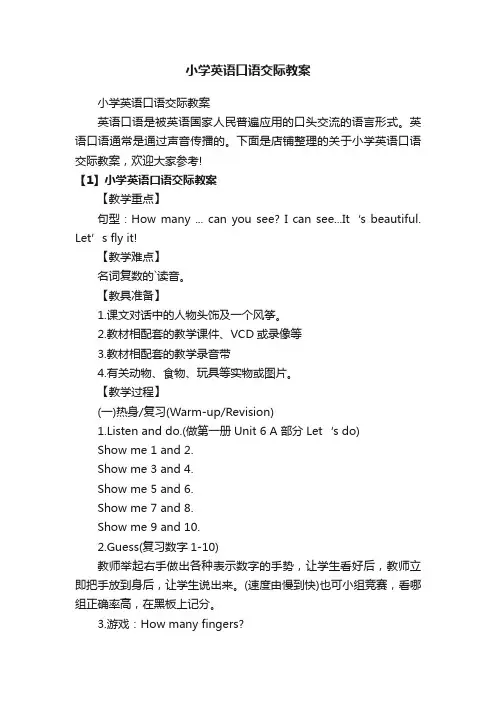
小学英语口语交际教案小学英语口语交际教案英语口语是被英语国家人民普遍应用的口头交流的语言形式。
英语口语通常是通过声音传播的。
下面是店铺整理的关于小学英语口语交际教案,欢迎大家参考!【1】小学英语口语交际教案【教学重点】句型:How many ... can you see? I can see...It‘s beautiful. Let’s fly it!【教学难点】名词复数的`读音。
【教具准备】1.课文对话中的人物头饰及一个风筝。
2.教材相配套的教学课件、VCD或录像等3.教材相配套的教学录音带4.有关动物、食物、玩具等实物或图片。
【教学过程】(一)热身/复习(Warm-up/Revision)1.Listen and do.(做第一册Unit 6 A 部分Let‘s do)Show me 1 and 2.Show me 3 and 4.Show me 5 and 6.Show me 7 and 8.Show me 9 and 10.2.Guess(复习数字1-10)教师举起右手做出各种表示数字的手势,让学生看好后,教师立即把手放到身后,让学生说出来。
(速度由慢到快)也可小组竞赛,看哪组正确率高,在黑板上记分。
3.游戏:How many fingers?1) 教师伸出4个手指问学生:How many fingers? 学生回答:Four. 教师继续问:How many fingers can you see? 引导学生回答:I can see four fingers.【2】小学英语口语交际教案【教学重点】听、说、认读几个形容词small,big,long,short 。
听懂含有形容词的几个指令,并按指令做动作。
【教学难点】单词small 中[ l ] 的发音,舌头要上卷。
【教具准备】1 教师准备教材配套的录音带。
2 教师准备Let‘s learn 部分的课件。
3 学生准备动物玩具,每人带1-2个。
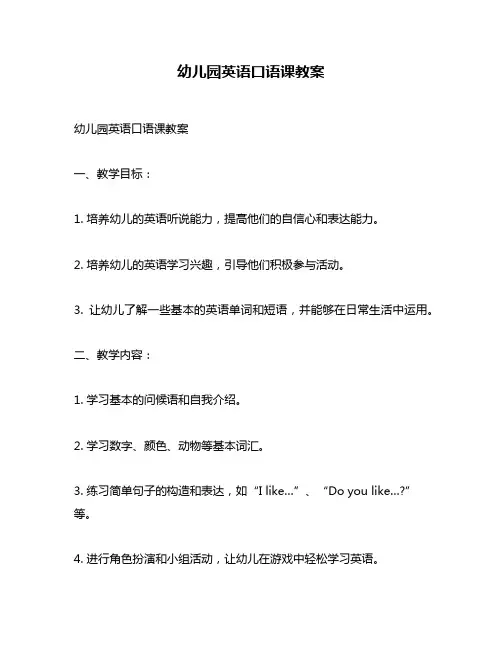
幼儿园英语口语课教案幼儿园英语口语课教案一、教学目标:1. 培养幼儿的英语听说能力,提高他们的自信心和表达能力。
2. 培养幼儿的英语学习兴趣,引导他们积极参与活动。
3. 让幼儿了解一些基本的英语单词和短语,并能够在日常生活中运用。
二、教学内容:1. 学习基本的问候语和自我介绍。
2. 学习数字、颜色、动物等基本词汇。
3. 练习简单句子的构造和表达,如“I like…”、“Do you like…?”等。
4. 进行角色扮演和小组活动,让幼儿在游戏中轻松学习英语。
三、教学步骤:1. 热身活动:唱歌跳舞(10分钟)老师可以根据孩子们喜欢的歌曲或舞蹈来进行热身活动。
通过唱歌跳舞让孩子们放松身心,进入学习状态。
2. 学习基本问候语和自我介绍(20分钟)老师可以先用图片或实物向孩子们展示问候语和自我介绍的表达方式,然后通过模仿老师的口型和动作来学习。
接着,让孩子们两两配对进行练习,并鼓励他们在班级中互相问候和自我介绍。
3. 学习数字、颜色、动物等基本词汇(30分钟)老师可以通过图片或实物向孩子们展示数字、颜色和动物等基本词汇,并用简单的语言教授。
接着,让孩子们进行听写和朗读练习。
4. 练习简单句子的构造和表达(20分钟)老师可以让孩子们用“I like…”、“Do you like…?”等句型进行练习,让他们学会表达自己的喜好和兴趣。
接着,让孩子们进行小组活动,在游戏中运用所学内容。
5. 结束活动:游戏时间(20分钟)老师可以安排一些有趣的英语游戏,如猜单词、说故事等,让孩子们在游戏中巩固所学内容,并增强英语学习的兴趣。
四、教学重点:1. 培养幼儿的英语听说能力。
2. 培养幼儿的英语学习兴趣。
3. 让幼儿了解一些基本的英语单词和短语,并能够在日常生活中运用。
五、教学难点:1. 如何让幼儿积极参与英语口语课,从而提高他们的听说能力。
2. 如何调动幼儿的学习兴趣,让他们在轻松愉快的氛围中学习英语。
六、教学方法:1. 以游戏为主,让孩子们在游戏中轻松愉快地学习英语。
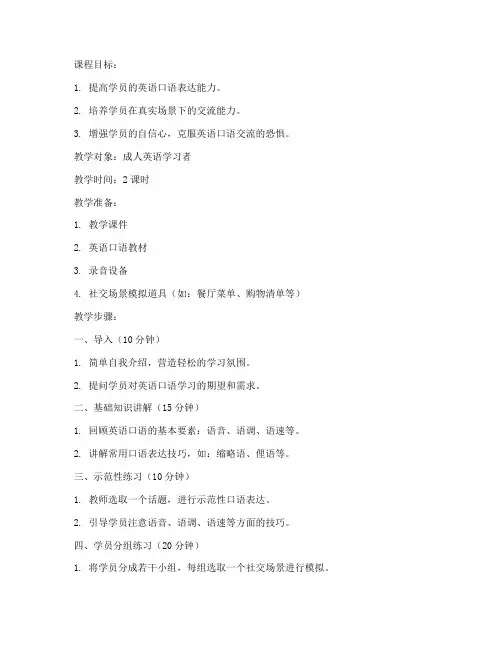
课程目标:1. 提高学员的英语口语表达能力。
2. 培养学员在真实场景下的交流能力。
3. 增强学员的自信心,克服英语口语交流的恐惧。
教学对象:成人英语学习者教学时间:2课时教学准备:1. 教学课件2. 英语口语教材3. 录音设备4. 社交场景模拟道具(如:餐厅菜单、购物清单等)教学步骤:一、导入(10分钟)1. 简单自我介绍,营造轻松的学习氛围。
2. 提问学员对英语口语学习的期望和需求。
二、基础知识讲解(15分钟)1. 回顾英语口语的基本要素:语音、语调、语速等。
2. 讲解常用口语表达技巧,如:缩略语、俚语等。
三、示范性练习(10分钟)1. 教师选取一个话题,进行示范性口语表达。
2. 引导学员注意语音、语调、语速等方面的技巧。
四、学员分组练习(20分钟)1. 将学员分成若干小组,每组选取一个社交场景进行模拟。
2. 每组学员根据场景准备对话内容,并互相练习。
3. 教师巡回指导,纠正学员的发音、语调等问题。
五、情景模拟(15分钟)1. 教师提供模拟场景,如:餐厅点餐、购物、问路等。
2. 学员分组进行角色扮演,模拟真实场景下的英语口语交流。
3. 教师对学员的表现进行点评,提出改进意见。
六、总结与反馈(10分钟)1. 教师对本次课程进行总结,强调口语表达的要点。
2. 学员分享学习心得,提出自己的疑问。
3. 教师针对学员提出的问题进行解答。
教学评价:1. 观察学员在课堂上的参与度,评估学员的学习积极性。
2. 关注学员在情景模拟中的表现,评价学员的口语表达能力。
3. 收集学员的学习反馈,了解教学效果。
课后作业:1. 学员每天至少练习英语口语15分钟,可以选择模仿教材中的对话或自编对话。
2. 学员每周至少观看一部英语电影或电视剧,提高听力水平。
备注:1. 教师应根据学员的学习进度和需求,调整教学内容和难度。
2. 鼓励学员在日常生活中多使用英语,提高实际应用能力。
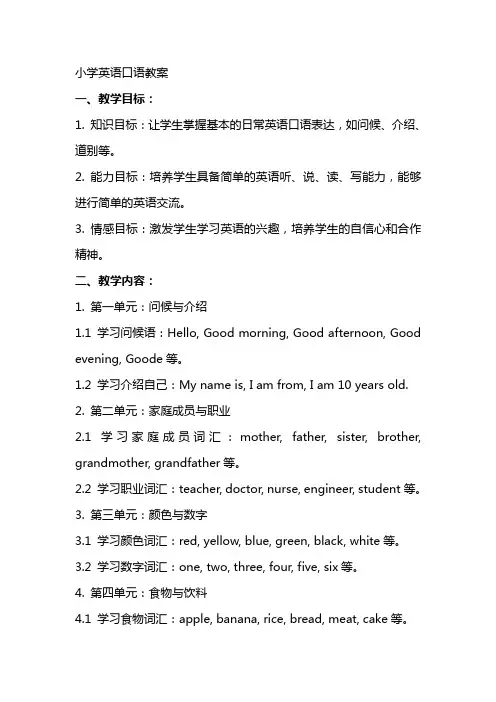
小学英语口语教案一、教学目标:1. 知识目标:让学生掌握基本的日常英语口语表达,如问候、介绍、道别等。
2. 能力目标:培养学生具备简单的英语听、说、读、写能力,能够进行简单的英语交流。
3. 情感目标:激发学生学习英语的兴趣,培养学生的自信心和合作精神。
二、教学内容:1. 第一单元:问候与介绍1.1 学习问候语:Hello, Good morning, Good afternoon, Good evening, Goode等。
1.2 学习介绍自己:My name is, I am from, I am 10 years old.2. 第二单元:家庭成员与职业2.1 学习家庭成员词汇:mother, father, sister, brother, grandmother, grandfather等。
2.2 学习职业词汇:teacher, doctor, nurse, engineer, student等。
3. 第三单元:颜色与数字3.1 学习颜色词汇:red, yellow, blue, green, black, white等。
3.2 学习数字词汇:one, two, three, four, five, six等。
4. 第四单元:食物与饮料4.1 学习食物词汇:apple, banana, rice, bread, meat, cake等。
4.2 学习饮料词汇:water, milk, coffee, tea, orange juice等。
5. 第五单元:天气与季节5.1 学习天气词汇:sunny, cloudy, rny, windy, snowy等。
5.2 学习季节词汇:spring, summer, autumn, winter等。
三、教学方法:1. 情景教学法:通过设定真实的生活情境,让学生在实际语境中学习英语口语。
2. 互动教学法:引导学生积极参与课堂活动,进行同伴交流,提高口语表达能力。
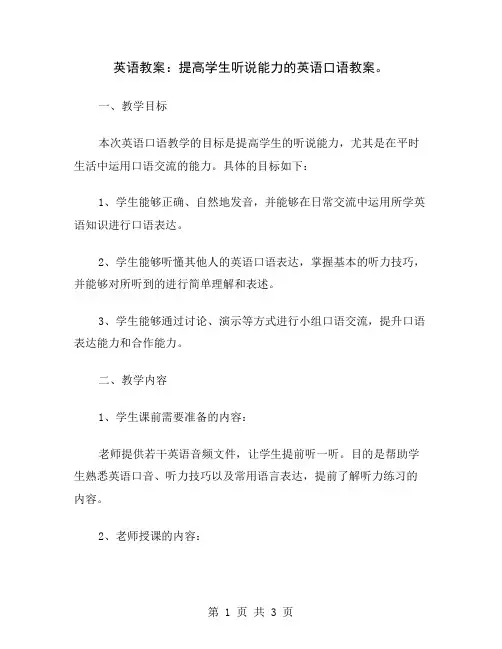
英语教案:提高学生听说能力的英语口语教案。
一、教学目标本次英语口语教学的目标是提高学生的听说能力,尤其是在平时生活中运用口语交流的能力。
具体的目标如下:1、学生能够正确、自然地发音,并能够在日常交流中运用所学英语知识进行口语表达。
2、学生能够听懂其他人的英语口语表达,掌握基本的听力技巧,并能够对所听到的进行简单理解和表述。
3、学生能够通过讨论、演示等方式进行小组口语交流,提升口语表达能力和合作能力。
二、教学内容1、学生课前需要准备的内容:老师提供若干英语音频文件,让学生提前听一听。
目的是帮助学生熟悉英语口音、听力技巧以及常用语言表达,提前了解听力练习的内容。
2、老师授课的内容:(1)英语发音,包括语言的基本构音方式:口型、口腔姿势以及声音的发出方式。
(2)听力技巧,包括如何判断听力重点、如何提高听音时的集中程度、如何正确使用词典等。
(3)交流能力训练,通过小组活动、角色扮演等方式,让学生进行实践性训练,提高口语表达的自信心和能力。
三、教学步骤1、开头环节:让学生熟悉英语音频文件并介绍今天的教学内容。
老师播放一段英语音频,让学生一起聆听。
接下来,老师介绍今天的教学内容,并告诉学生接下来要学习的英语音频文件。
2、教学环节:学生跟读英语语音文件,学生听力训练,小组口语交流训练。
老师带领学生一起跟读英语语音文件,并帮助学生改正发音中可能出现的错误和不规范的发音方式。
随后,通过听力练习,让学生提高听音时的集中程度和对重点词句的注意力。
通过小组口语交流的形式,让学生展示所学英语知识,发掘和弥补不足之处。
3、结束环节:总结教学成果并布置课后作业。
老师对学生的听力训练、发音和口语交流进行总结,同时布置课后作业,加强学习效果。
同时,提醒学生可以保持每日学习习惯,多听英语音频文件和交流,加强对英语的理解和应用能力。
四、教学反思通过今天的英语口语教学,学生的口语表达能力得到了进一步加强,也增强了学生的英语听说应用能力。
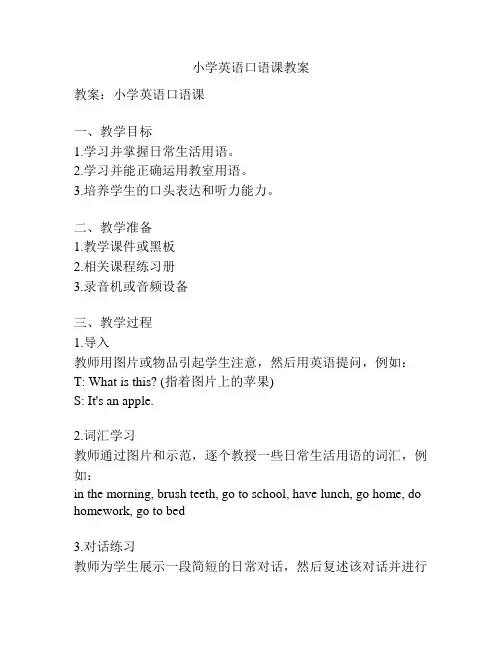
小学英语口语课教案教案:小学英语口语课一、教学目标1.学习并掌握日常生活用语。
2.学习并能正确运用教室用语。
3.培养学生的口头表达和听力能力。
二、教学准备1.教学课件或黑板2.相关课程练习册3.录音机或音频设备三、教学过程1.导入教师用图片或物品引起学生注意,然后用英语提问,例如:T: What is this? (指着图片上的苹果)S: It's an apple.2.词汇学习教师通过图片和示范,逐个教授一些日常生活用语的词汇,例如:in the morning, brush teeth, go to school, have lunch, go home, do homework, go to bed3.对话练习教师为学生展示一段简短的日常对话,然后复述该对话并进行角色扮演,例如:T: Good morning, Bob.S1: Good morning, Alice.T: How are you today?S1: I'm fine, thank you. And you?T: I'm good too.S1: That's great. Let's go to school now.S2: OK.4.游戏活动教师通过游戏帮助学生巩固所学词汇和句型,例如“连连看”游戏或“找出不同”的游戏。
5.听力训练教师播放一段简短的对话,要求学生通过听力理解并回答问题,例如:T: What did the boy do in the morning? (对话中提到的活动有:brush teeth, eat breakfast, go to school)S1: He brushed his teeth.6.练习册巩固教师分发练习册,要求学生完成相关练习,例如填空、选择题等。
7.板书总结教师根据本节课的内容,将重点词汇或句型记录在黑板上,让学生复习。
四、课后作业1.完成练习册上的作业。
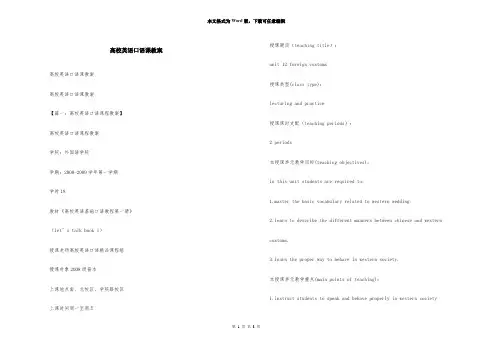
高校英语口语课教案高校英语口语课教案高校英语口语课教案【篇一:高校英语口语课程教案】高校英语口语课程教案学院:外国语学院学期:2008-2009学年第一学期学时18教材《高校英语基础口语教程第一册》(let’s talk book 1)授课老师高校英语口语精品课程组授课对象2008级普本上课地点南、北校区、学院路校区上课时间周一至周五授课题目(teaching title):unit 12 foreign customs授课类型(class type):lecturing and practice授课课时支配(teaching periods):2 periods本授课单元教学目标(teaching objectives):in this unit students are required to:1.master the basic vocabulary related to western wedding.2.learn to describe the different manners between chinese and western customs.3.learn the proper way to behave in western society.本授课单元教学重点(main points of teaching):1.instruct students to speak and behave properly in western societyconcerning some important events.2.analyze the different manners between chinese and western countries.本授课单元教学难点(difficult points of teaching):instruct the students to use cultural-related words to describe andcompare the proper manners in chinese and western events.教学手段(teaching aids) multimedia (audios, videos, pictures, texts), blackboard.本授课单元教学步骤准时间安排(teaching procedures and time allotment):1. warming-up activities (about 15 minutes)1.1 role play: a typical western wedding (about 10 minutes) student are assigned the task in the previous class. they are asked toperform a typical western wedding. useful materials and informationshould be collected before the class. (about 10 minutes)1.2 wedding-related vocabulary and oath of wedding: (about 5 minutes)after the role play, the wedding-related vocabulary and oath of wedding should be introduced to all the students:wedding-related vocabularybridebridegroombridesmaidgroomsmanpastorringoathchurchoath of weddingpastor:dearly beloved, we are gathered together here in the sight of god and inthe face of this congregation to join together this man and this womanin holy matrimony, which is an honorable estate, instituted in the timeof man’s innocence.if any man can show any just cause or impediment why they may not be lawful joined together, why they may not be lawfully joined together, let himspeak now or for ever hold his peace.do you promise to love her, comfort her, honor and keep her, in sicknessan health and forsaking all others, keep thee only unto her for as longas you both shall live.bride and bridegroom:yes, i do.2.in-class activities2.1 individual work (about 8 minutes).1.1 comparison: differences between a typical western wedding and a traditional chinesewedding.students are required to compare the weddings and make a discussion ontheir differences.sample for reference:chinese wedding:? color of wedding dress: white ? location of wedding celebration: lobby of home? wedding process: presided by the master of ceremony ? others: fire cracks, character of double happiness ?western wedding? color of wedding dress: white? location of wedding celebration: church? wedding process: presided by pastor。
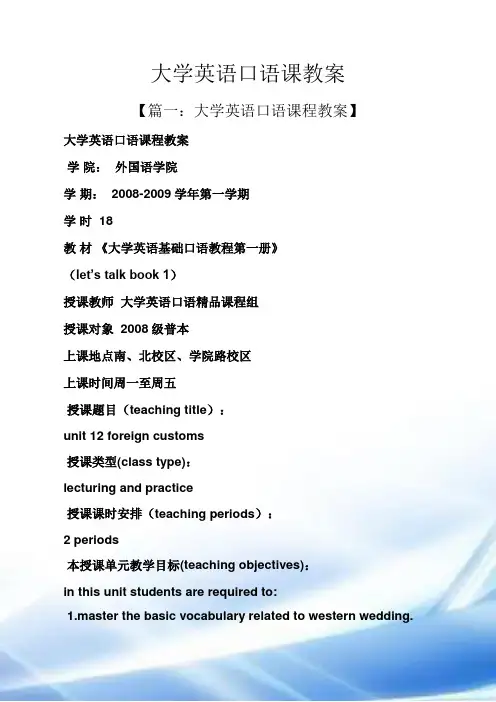
大学英语口语课教案【篇一:大学英语口语课程教案】大学英语口语课程教案学院:外国语学院学期: 2008-2009学年第一学期学时 18教材《大学英语基础口语教程第一册》(let’s talk book 1)授课教师大学英语口语精品课程组授课对象 2008级普本上课地点南、北校区、学院路校区上课时间周一至周五授课题目(teaching title):unit 12 foreign customs授课类型(class type):lecturing and practice授课课时安排(teaching periods):2 periods本授课单元教学目标(teaching objectives):in this unit students are required to:1.master the basic vocabulary related to western wedding.2.learn to describe the different manners between chinese and westerncustoms.3.learn the proper way to behave in western society.本授课单元教学重点(main points of teaching):1.instruct students to speak and behave properly in western societyconcerning some important events.2.analyze the different manners between chinese and western countries.本授课单元教学难点(difficult points of teaching):instruct the students to use cultural-related words to describe andcompare the proper manners in chinese and western events.教学手段(teaching aids)multimedia (audios, videos, pictures, texts), blackboard.本授课单元教学步骤及时间分配 (teaching procedures and time allotment):1. warming-up activities (about 15 minutes)1.1 role play: a typical western wedding (about 10 minutes)student are assigned the task in the previous class. they are asked toperform a typical western wedding. useful materials and informationshould be collected before the class. (about 10 minutes)1.2 wedding-related vocabulary and oath of wedding: (about 5 minutes)after the role play, the wedding-related vocabulary and oath of weddingshould be introduced to all the students:wedding-related vocabularybridebridegroombridesmaidgroomsmanpastorringoathchurchoath of weddingpastor:dearly beloved, we are gathered together here in the sight of god and inthe face of this congregation to join together this man and this womanin holy matrimony, which is an honorable estate, instituted in the timeof man’s innocence.if any man can show any just cause or impediment why they may not be lawfuljoined together, why they may not be lawfully joined together, let himspeak now or for ever hold his peace.do you promise to love her, comfort her, honor and keep her, in sicknessan health and forsaking all others, keep thee only unto her for as longas you both shall live.bride and bridegroom:yes, i do.2.in-class activities2.1 individual work (about 8 minutes).1.1 comparison: differences between a typical western wedding and a traditional chinesewedding.students are required to compare the weddings and make a discussion ontheir differences.sample for reference:chinese wedding:color of wedding dress: whitelocation of wedding celebration: lobby of homewedding process: presided by the master of ceremonyothers: fire cracks, character of double happinesswestern weddingcolor of wedding dress: whitelocation of wedding celebration: churchwedding process: presided by pastorothers: ring, flower, cake, bridesmaid, groomsman2.1.2 video clip: (about 15 minutes)watch the video. what mistakes do the man made in the dinner party?students are required to watch a 5-minutes short video about cultureconflict and to find out the wrong thing the man did in the dinner party.proper answer:a. greet people in his own wayb.talk to the people not besides himc. take retire as retard and keep talking about ite. perform extremely stupid in using restroom.f. bring his friend without being permitted2.1.3 listening practice (about 7 minutes)2.2 pair work (about 10 minutes)2.2.1 discussion in pairswestern manners: discuss with your partner what we should pay attention to in the western countries according to the following situations: having dinner, greeting, visiting others homesamples for reference:having dinner: knife and fork ; you have your own plate of food ; eat up all the;food on your plate; do not put food on the plate of your guests with your own fork; go dutch; tipsgreeting: the simplest thing to say is good morning, good afternoon or goodevening. this greeting is given to one whom you know only slightly, or to any one you are passing quickly. how are you is usually used when you are not in such a hurry. no answer is expected other than fine, thank you. hello is the commonest form of greeting between good friends. visiting other’s home: when invited to luncheon, dinner, or supper, it is veryimpolite to arrive late, as it is usually planned to have the meal at the exact hour given in the invitation.after the meal is over it is not polite to leave for at least half an hour, lest you seem to have come only for the meal. an evening dinner invitation usually implies that you stay for the whole evening.2.2.2 dialogue practice (about 15 minutes)imagine a visitor from the united states is coming to china. give advice on these topics:driving a car, giving gifts, traveling by bus or subway, eating in arestaurant respecting older people, using business cards, eating on the street, standing in line, using thetelephonesample:a. i will go to china next week.b. really? how long will you stay there?a. for several months. so would you please tell me some thing that i shouldpay attention to during my stay in china?b. of course. first, you should get accustomed to the chinese traffic. inthe street, there are a lot of transportation tools. bus, cars, motorcycle, bicycle.a. well, do it mean a busy traffic?b. yeah. in fact, the problem traffic jam is extremely serious in china.a. oh, i see. anything else? i’ve heard that chinese eating manner is greatly different with our us. is that true.b. well, nowadays there are a lot of western restaurants in china. but chinese has their own dinning customs. for example, in a typical chinese dinner, each dish is shared. chopsticks are used instead of knife and fork. one person would like to paythe bill as his treat.a. well, it seems that there are so many differences between the two countries.b. take it easy. chinese people are hospitable. you are surely to have good time there.2.3group work (about 20 minutes)debate: should chinese celebrate western holidays?each group presents their own ideas on the topic first. then a free debatewill be directed among students.sample:we should celebrate western holidaysi think we should celebrate western holiday. first, its a goodway for globalization, and we can know more about the culture in other country. secondly, foreigners will also have a chance to know more about the chinese culture. thus, we could avoid some culturalmisunderstandings.first,i do not think it is a bad things ,and the holiday is agood thing ,many people could celebrate not only the chinese people but also the american, and so on. second, many people go aboard every year, and they should adjust themselves to the aboard environment,so the must to celebrate the holiday,so i think we should celebrate it,and other people that come from union.we should not celebrate western holidaysto begin with, there are so many meaningful traditional festivalsin china, from which people could have a rest and get relax. in the festival, without the burden of work, people call on relatives, visit their respected teachers, and chat with their best friends. though the temperature is very could in that time, the atmosphere among people is very warm and happy. besides, there are other meaningful【篇二:大学英语教学设计】大学英语教学设计一、指导思想和理论依据大学英语是普通高等学校的一门重要公共基础课程。
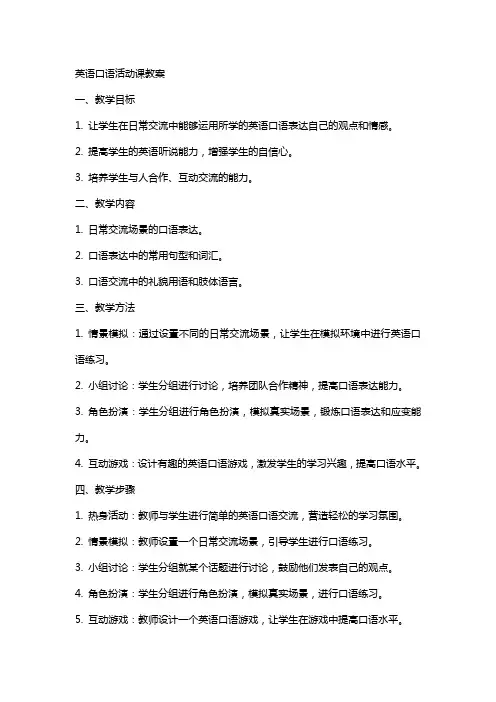
英语口语活动课教案一、教学目标1. 让学生在日常交流中能够运用所学的英语口语表达自己的观点和情感。
2. 提高学生的英语听说能力,增强学生的自信心。
3. 培养学生与人合作、互动交流的能力。
二、教学内容1. 日常交流场景的口语表达。
2. 口语表达中的常用句型和词汇。
3. 口语交流中的礼貌用语和肢体语言。
三、教学方法1. 情景模拟:通过设置不同的日常交流场景,让学生在模拟环境中进行英语口语练习。
2. 小组讨论:学生分组进行讨论,培养团队合作精神,提高口语表达能力。
3. 角色扮演:学生分组进行角色扮演,模拟真实场景,锻炼口语表达和应变能力。
4. 互动游戏:设计有趣的英语口语游戏,激发学生的学习兴趣,提高口语水平。
四、教学步骤1. 热身活动:教师与学生进行简单的英语口语交流,营造轻松的学习氛围。
2. 情景模拟:教师设置一个日常交流场景,引导学生进行口语练习。
3. 小组讨论:学生分组就某个话题进行讨论,鼓励他们发表自己的观点。
4. 角色扮演:学生分组进行角色扮演,模拟真实场景,进行口语练习。
5. 互动游戏:教师设计一个英语口语游戏,让学生在游戏中提高口语水平。
五、作业布置1. 学生回家后,与家人或朋友进行一次英语口语交流,尝试运用所学的内容。
2. 学生记录下自己的口语交流过程,思考自己在交流中的优点和不足,为下次上课做好准备。
六、教学评估1. 观察学生在课堂上的参与程度,评估他们的口语表达能力和自信心。
2. 通过小组讨论和角色扮演,评估学生的团队合作能力和交流技巧。
3. 通过互动游戏,评估学生的口语应变能力和对英语口语的兴趣。
七、教学资源1. 教学课件:包含日常交流场景、常用句型和词汇等。
2. 角色扮演道具:如帽子、围巾等,用于增强角色扮演的真实感。
3. 互动游戏材料:如卡片、骰子等,用于开展互动游戏。
八、教学注意事项1. 关注学生的个体差异,因材施教,给予每个学生充分的关注和鼓励。
2. 创造轻松、愉快的学习氛围,让学生敢于开口,勇于表达。
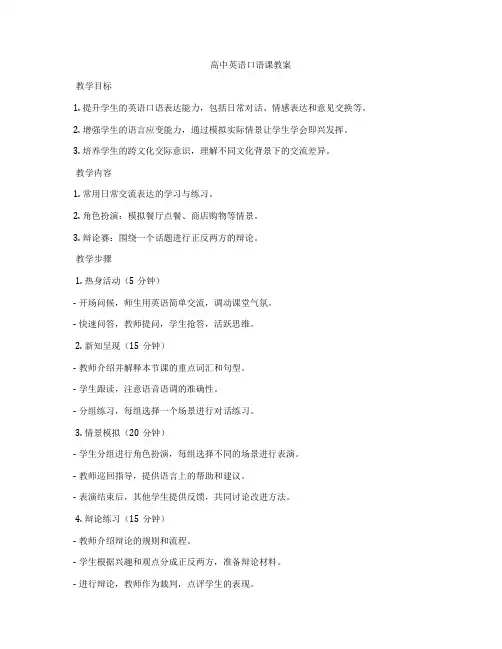
高中英语口语课教案教学目标1. 提升学生的英语口语表达能力,包括日常对话、情感表达和意见交换等。
2. 增强学生的语言应变能力,通过模拟实际情景让学生学会即兴发挥。
3. 培养学生的跨文化交际意识,理解不同文化背景下的交流差异。
教学内容1. 常用日常交流表达的学习与练习。
2. 角色扮演:模拟餐厅点餐、商店购物等情景。
3. 辩论赛:围绕一个话题进行正反两方的辩论。
教学步骤1. 热身活动(5分钟)- 开场问候,师生用英语简单交流,调动课堂气氛。
- 快速问答,教师提问,学生抢答,活跃思维。
2. 新知呈现(15分钟)- 教师介绍并解释本节课的重点词汇和句型。
- 学生跟读,注意语音语调的准确性。
- 分组练习,每组选择一个场景进行对话练习。
3. 情景模拟(20分钟)- 学生分组进行角色扮演,每组选择不同的场景进行表演。
- 教师巡回指导,提供语言上的帮助和建议。
- 表演结束后,其他学生提供反馈,共同讨论改进方法。
4. 辩论练习(15分钟)- 教师介绍辩论的规则和流程。
- 学生根据兴趣和观点分成正反两方,准备辩论材料。
- 进行辩论,教师作为裁判,点评学生的表现。
5. 总结反馈(5分钟)- 学生自我评价,分享今天的学习收获。
- 教师总结课堂表现,强调正确的学习方法和态度。
- 布置课后作业,要求学生准备下一节课的内容。
教学方法- 互动式教学,鼓励学生主动参与和表达。
- 分层次教学,根据学生的英语水平提供个性化指导。
- 利用多媒体工具,增加课堂的趣味性和互动性。
教学评价- 观察学生在模拟情景中的表现,评价其语言运用能力。
- 通过辩论活动考察学生的思维逻辑和语言组织能力。
- 课后作业的完成情况也是评价学生学习效果的重要依据。
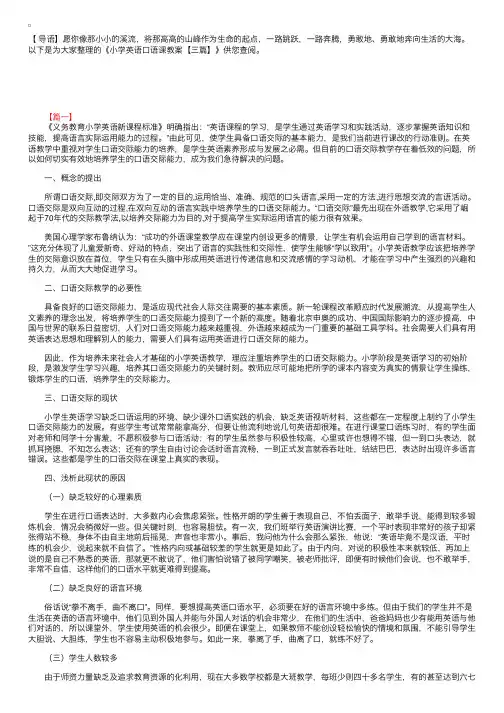
【导语】愿你像那⼩⼩的溪流,将那⾼⾼的⼭峰作为⽣命的起点,⼀路跳跃,⼀路奔腾,勇敢地、勇敢地奔向⽣活的⼤海。
以下是为⼤家整理的《⼩学英语⼝语课教案【三篇】》供您查阅。
【篇⼀】 《义务教育⼩学英语新课程标准》明确指出:“英语课程的学习,是学⽣通过英语学习和实践活动,逐步掌握英语知识和技能,提⾼语⾔实际运⽤能⼒的过程。
”由此可见,使学⽣具备⼝语交际的基本能⼒,是我们当前进⾏课改的⾏动准则。
在英语教学中重视对学⽣⼝语交际能⼒的培养,是学⽣英语素养形成与发展之必需。
但⽬前的⼝语交际教学存在着低效的问题,所以如何切实有效地培养学⽣的⼝语交际能⼒,成为我们急待解决的问题。
⼀、概念的提出 所谓⼝语交际,即交际双⽅为了⼀定的⽬的,运⽤恰当、准确、规范的⼝头语⾔,采⽤⼀定的⽅法,进⾏思想交流的⾔语活动。
⼝语交际是双向互动的过程,在双向互动的语⾔实践中培养学⽣的⼝语交际能⼒。
“⼝语交际”最先出现在外语教学,它采⽤了崛起于70年代的交际教学法,以培养交际能⼒为⽬的,对于提⾼学⽣实际运⽤语⾔的能⼒很有效果。
美国⼼理学家布鲁纳认为:“成功的外语课堂教学应在课堂内创设更多的情景,让学⽣有机会运⽤⾃⼰学到的语⾔材料。
”这充分体现了⼉童爱新奇、好动的特点,突出了语⾔的实践性和交际性,使学⽣能够“学以致⽤”。
⼩学英语教学应该把培养学⽣的交际意识放在⾸位,学⽣只有在头脑中形成⽤英语进⾏传递信息和交流感情的学习动机,才能在学习中产⽣强烈的兴趣和持久⼒,从⽽⼤⼤地促进学习。
⼆、⼝语交际教学的必要性 具备良好的⼝语交际能⼒,是适应现代社会⼈际交往需要的基本素质。
新⼀轮课程改⾰顺应时代发展潮流,从提⾼学⽣⼈⽂素养的理念出发,将培养学⽣的⼝语交际能⼒提到了⼀个新的⾼度。
随着北京申奥的成功、中国国际影响⼒的逐步提⾼,中国与世界的联系⽇益密切,⼈们对⼝语交际能⼒越来越重视,外语越来越成为⼀门重要的基础⼯具学科。
社会需要⼈们具有⽤英语表达思想和理解别⼈的能⼒,需要⼈们具有运⽤英语进⾏⼝语交际的能⼒。
小学英语口语教学教案(6篇)以下是网友分享的关于小学英语口语教学教案的资料6篇,希望对您有所帮助,就爱阅读感谢您的支持。
篇一:小学英语口语教学教案(一) 英语听说唱综述:在新课标的要求下,小学英语应该以培养学生的兴趣与实际运用能力为主。
根据小孩子活泼好动,模仿性强的心理特点,这门课程主要围绕学唱英文歌(Singing songs)和模仿对话(Let’s talk)两部分,让学生们感受到英语的魅力。
歌曲能激发他们的兴趣,提高学习效益,课前课后唱一首英文歌,集中学生注意力的同时,寓学于唱。
同时,模仿对话的环节,增加学生的实践量,训练语音语调,提高学生的听说能力,创设轻松愉快的学习环境和学习氛围。
课程安排:第一节课:1-10分钟,教师和学生互相自我介绍,教师介绍英语听说唱的开课目的、该课的特点、大概的课程安排以及应该怎样学好。
11-20分钟,教师教会学生一首简单的英文歌Little Bird。
21-25分钟,教师介绍这首英文歌曲的意思,让学生们懂得学习英语有很多途径和方式并且学习小小鸟努力勇敢飞的精神。
25-30分钟,教师让学生们看一小段小学英语教材的视频,温故知新,并从中巩固一些句型,如“This is our school”和”Where is the playground?”等。
31-38分钟,学生模仿视频进行简单对话,锻炼学生开口说英语能力。
39-40分钟,结束前唱一首Little Bird,让学生们保持注意力,解除疲劳,身心愉快,对课堂留下美好的影响,从而期待下一节课的到来。
第二节课:1-15分钟,教师教会学生一首简单的英文歌曲Catch theeels。
16-20分钟,播放中文版的儿歌抓泥鳅,让一个个英语词句放进美妙的轻快的歌曲中,进入孩子们的头脑中。
21-30分钟,教师播放一小段与小学英语教材相关的视频,学生练习模仿对话。
31-38分钟,邀请学生上台表演对话。
39-40分钟,合唱英文歌曲,结束课程教学,并且教师鼓励大家多听多说多唱,寓学于乐。
一、教学目标1. 知识目标:掌握本节课所学的英语口语表达。
2. 能力目标:提高学生的英语口语表达能力,培养学生的口语交际能力。
3. 情感目标:激发学生对英语口语学习的兴趣,培养学生的自信心。
二、教学内容1. 词汇:本节课所学的词汇。
2. 句型:本节课所学的句型。
3. 话题:本节课所讨论的话题。
三、教学过程1. 导入(1)热身活动:进行简单的英语口语交流,如问候、介绍自己等。
(2)引入话题:根据本节课的话题,引导学生进行相关讨论。
2. 词汇学习(1)展示本节课所学的词汇,让学生跟读并模仿发音。
(2)让学生用所学的词汇造句,教师进行点评和纠正。
3. 句型学习(1)展示本节课所学的句型,让学生跟读并模仿发音。
(2)让学生用所学的句型进行口语练习,教师进行点评和纠正。
4. 话题讨论(1)让学生围绕本节课的话题进行小组讨论,鼓励他们用英语表达自己的观点。
(2)教师巡视指导,帮助学生纠正发音和语法错误。
5. 总结与反思(1)教师对本节课所学内容进行总结,强调重点和难点。
(2)学生进行自我反思,总结自己在口语学习中的收获和不足。
四、课后作业1. 复习本节课所学词汇和句型。
2. 准备关于本节课话题的口语表达,下节课进行展示。
教案范文:一、教学目标1. 知识目标:掌握本节课所学的英语口语表达,如“how are you?”、“What's your name?”等。
2. 能力目标:提高学生的英语口语表达能力,培养学生的口语交际能力。
3. 情感目标:激发学生对英语口语学习的兴趣,培养学生的自信心。
二、教学内容1. 词汇:how are you?、What's your name?、Nice to meet you、How old are you?等。
2. 句型:How are you?、What's your name?、Nice to meet you、How old are you?等。
英语口语活动课教案第一章:课程简介1.1 课程目标本课程旨在通过各种口语活动,提高学生的英语口语表达能力,增强学生的自信心,使他们在日常生活和工作中能够熟练使用英语进行沟通。
1.2 课程内容本课程将包括各种口语活动,如角色扮演、小组讨论、辩论、演讲等,以及一些日常口语表达的练习。
1.3 教学方法本课程将采用互动式教学方法,鼓励学生积极参与,充分发挥他们的主观能动性。
第二章:角色扮演2.1 活动目的通过角色扮演,提高学生的英语口语表达能力,培养他们的表演能力。
2.2 活动内容学生分成小组,每组选择一个日常生活中的场景,如在餐厅、在机场、在医院等,进行角色扮演。
2.3 活动步骤(1)学生分组,选择场景;(2)学生准备角色扮演;(3)学生进行角色扮演;(4)教师对学生的表现进行点评。
第三章:小组讨论3.1 活动目的通过小组讨论,提高学生的英语口语表达能力,培养他们的团队合作能力。
3.2 活动内容学生分成小组,每组选择一个话题,如环保、教育、旅游等,进行小组讨论。
3.3 活动步骤(1)学生分组,选择话题;(2)学生准备小组讨论;(3)学生进行小组讨论;(4)教师对学生的表现进行点评。
第四章:辩论4.1 活动目的通过辩论,提高学生的英语口语表达能力,培养他们的逻辑思维能力。
4.2 活动内容学生分成两队,选择一个辩论题目,如“是否应该使用手机”、“是否应该吸烟”等,进行辩论。
4.3 活动步骤(1)学生分组,选择辩论题目;(2)学生准备辩论;(3)学生进行辩论;(4)教师对学生的表现进行点评。
第五章:演讲5.1 活动目的通过演讲,提高学生的英语口语表达能力,培养他们的公共演讲能力。
5.2 活动内容学生选择一个自己感兴趣的话题,进行演讲。
5.3 活动步骤(1)学生选择演讲话题;(2)学生准备演讲;(3)学生进行演讲;(4)教师对学生的表现进行点评。
第六章:日常口语表达练习6.1 活动目的通过日常口语表达练习,使学生能够熟练运用日常英语进行交流。
课程名称:大学英语口语授课班级:大一英语班授课时间:2课时授课地点:多媒体教室教学目标:1. 培养学生运用英语进行日常交流的能力。
2. 提高学生的英语听说水平,增强学生的自信心。
3. 培养学生的团队合作精神,提高学生的社交能力。
教学重点:1. 常用口语表达方式及句型。
2. 日常生活中的交际场景。
教学难点:1. 学生在口语表达中的语法错误和发音问题。
2. 学生在团队合作中的沟通不畅。
教学过程:第一课时一、导入1. 教师用英语简短介绍自己,并引导学生用英语进行自我介绍。
2. 学生分组,每组选一名代表进行自我介绍。
二、口语表达练习1. 教师列举一些常用口语表达方式及句型,如:How are you?、What's your name?、Nice to meet you.等。
2. 学生跟读并模仿,教师纠正发音和语法错误。
3. 学生分组进行对话练习,教师巡回指导。
三、情景模拟1. 教师设定一个交际场景,如:购物、餐厅点餐等。
2. 学生分组,每组进行情景模拟,教师点评并纠正错误。
四、课堂小结1. 教师总结本节课所学内容,强调重点和难点。
2. 学生分享自己的学习心得。
第二课时一、复习导入1. 教师提问上节课所学内容,学生回答。
2. 学生分组进行口语练习,教师点评。
二、角色扮演1. 教师设定一个交际场景,如:求职面试、旅行安排等。
2. 学生分组,每组进行角色扮演,教师点评并纠正错误。
三、小组讨论1. 教师提出一个话题,如:环保、健康饮食等。
2. 学生分组进行讨论,每组选一名代表发言,教师点评。
四、课堂小结1. 教师总结本节课所学内容,强调重点和难点。
2. 学生分享自己的学习心得。
教学评价:1. 学生课堂参与度、口语表达水平。
2. 学生对交际场景的应对能力。
3. 学生对课堂内容的掌握程度。
教学反思:1. 关注学生的发音和语法错误,及时纠正。
2. 鼓励学生积极参与课堂活动,提高口语表达能力。
3. 根据学生的实际情况,调整教学内容和进度。
英语口语课教案5篇(经典版)编制人:__________________审核人:__________________审批人:__________________编制单位:__________________编制时间:____年____月____日序言下载提示:该文档是本店铺精心编制而成的,希望大家下载后,能够帮助大家解决实际问题。
文档下载后可定制修改,请根据实际需要进行调整和使用,谢谢!并且,本店铺为大家提供各种类型的经典范文,如总结报告、演讲致辞、事迹材料、学习心得、合同协议、条据文书、自我鉴定、教学资料、作文大全、其他范文等等,想了解不同范文格式和写法,敬请关注!Download tips: This document is carefully compiled by this editor. I hope that after you download it, it can help you solve practical problems. The document can be customized and modified after downloading, please adjust and use it according to actual needs, thank you!Moreover, our store provides various types of classic sample essays for everyone, such as summary reports, speeches, deeds, learning experiences, contract agreements, normative documents, self-evaluation, teaching materials, essay summaries, other sample essays, etc. If you want to learn about different sample essay formats and writing methods, please stay tuned!英语口语课教案5篇一份优质的教案能够帮助教师更好地调整教学节奏,确保学生的学习效果最大化,写好教案需要教师对教学反馈进行及时和有效的处理,以下是本店铺精心为您推荐的英语口语课教案5篇,供大家参考。
一、课程名称:大学英语口语二、授课班级:XX级XX班三、授课教师:[教师姓名]四、授课时间:2023年[具体日期]五、授课地点:[具体教室名称]六、教学目标:1. 知识目标:- 学生能够掌握基本的口语交际技巧,包括听力理解、口语表达、词汇和语法运用。
- 学生能够理解并运用常用口语表达和句型,提高日常英语交流能力。
2. 技能目标:- 学生能够通过小组讨论、角色扮演等方式,积极参与课堂活动,提高口语表达能力。
- 学生能够通过模拟真实场景,提高实际英语口语交际能力。
3. 情感态度目标:- 学生能够对英语口语学习产生兴趣,增强学习英语的自信心。
- 学生能够通过英语口语学习,增进对英语文化的了解和认识。
七、教学内容:1. 单元主题:Travel and Tourism(旅游)2. 教学重点:- 旅游相关词汇和句型。
- 旅游场景下的口语交际技巧。
3. 教学难点:- 在不同语境下运用正确的词汇和句型。
- 流利、自然地进行口语表达。
八、教学过程:第一课时1. 导入:- 利用图片、视频等方式引入旅游主题,激发学生学习兴趣。
2. 词汇学习:- 教授与旅游相关的词汇,如:tourism, travel, hotel, attraction, etc.- 通过游戏、练习等方式帮助学生记忆词汇。
3. 句型学习:- 教授旅游场景下的常用句型,如:Can you recommend a good hotel? Where can I find the nearest attraction? etc.- 通过对话练习,让学生运用句型进行交流。
4. 课堂活动:- 分组讨论:让学生分组讨论自己曾经旅游过的城市,并分享自己的旅行经历。
- 角色扮演:让学生扮演旅游顾问和游客,模拟真实场景进行对话。
第二课时1. 复习:- 回顾上节课学习的词汇和句型。
2. 深入讲解:- 结合具体案例,讲解旅游场景下的口语交际技巧。
3. 课堂活动:- 小组讨论:让学生分组讨论如何制定旅行计划,并分享自己的计划。